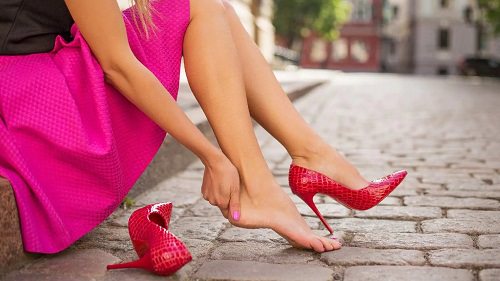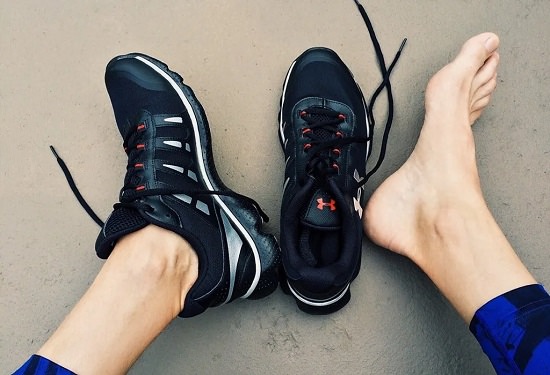Step into comfort, and bid shoe bites goodbye, with the secret formula to shoe bliss! Find out what to apply on shoes to avoid shoe bite.
Shoe bite refers to a condition where the friction between your shoes and your skin causes irritation, redness, and the formation of blisters or sores. When your shoes repeatedly rub against certain areas of your feet, it can create pressure points that result in discomfort and pain. These pressure points can irritate the skin, and if the friction continues, even listers can form.
You may experience show bites commonly in areas where the shoes rub against the skin, such as the back of the heel, sides of the foot, or toes. The affected area may become red, swollen, and tender. If the friction persists, a blister can develop, which is a fluid-filled pocket that forms between the layers of the skin as a protective response.
Shoe bites can occur in the following conditions where:
- You’re wearing new shoes that haven’t been broken in
- Shoes that are too tight or too loose
- Shoes that have materials that cause excessive friction.
- Moisture, such as sweat, can contribute to shoe bites by increasing friction.
- In some cases, individual foot structures or abnormalities can make certain areas more prone to shoe bites.
To treat shoe bites, it’s important to clean the affected area with mild soap and water, apply an antiseptic ointment, and cover it with a sterile bandage or dressing. Avoid popping the blister, as it provides a natural protective barrier. If the shoe bite becomes infected or doesn’t heal properly, it’s advisable to seek medical attention.
What To Apply on Shoes to Avoid Shoe Bite
- Well-Fitting Shoes: Make sure your shoes are the right size and provide enough room for your feet to move comfortably. Shoes that are too tight or too loose are more likely to cause friction and result in shoe bites.
- Break in Your Shoes: Before wearing new shoes for an extended period, wear them for short periods to allow them to mold to the shape of your feet. This can help reduce friction and prevent shoe bites.
- Use Moleskin or Blister Pads: Apply moleskin or blister pads to areas that are prone to shoe bites, such as the back of the heel or areas where the shoes rub against your skin. These products provide a protective barrier and reduce friction.
- Wear Socks: Wearing socks can act as a cushion between your skin and the shoes. This reduces friction and the likelihood of shoe bites. Opt for socks made of moisture-wicking materials to keep your feet dry and reduce the chance of blisters.
- Use Petroleum Jelly or Lubricants: Apply a thin layer of petroleum jelly or a specialized foot lubricant to areas that are prone to shoe bites. These lubricants reduce friction and can help prevent blisters.
- Adjust Shoe Laces or Straps: If your shoes have laces or straps, adjust them to achieve a snug but comfortable fit. Avoid lacing your shoes too tightly, as this can increase friction and lead to shoe bites.
Remember, prevention is key, but if you do get a shoe bite, make sure to clean the area with mild soap and water, apply an antiseptic ointment, and cover it with a sterile bandage or dressing until it heals. If the shoe bite becomes infected or doesn’t heal properly, consult a healthcare professional.
Shoe Bite: Reasons
Shoe bites occur due to friction between your shoes and your skin. Several factors contribute to the occurrence of shoe bites:
- New shoes are often stiff and need time to break in. If you wear them for extended periods before they have adjusted to your feet, the friction can cause shoe bites. Similarly, shoes that are too tight, too loose, or have improper sizing can create excessive pressure points, leading to friction and shoe bites.
- Material and construction of shoes: The type of material and construction of your shoes can affect their comfort and the likelihood of causing shoe bites. Stiff or rigid materials, rough seams, or hard edges within the shoe can rub against your skin and cause irritation.
- Moisture, such as sweat, can increase friction between your skin and shoes, making you more susceptible to shoe bites. Prolonged moisture can also soften the skin, making it more prone to blisters.
- Individual differences in foot structure, such as bony prominences or foot deformities, can increase the likelihood of shoe bites. Additionally, factors like excessive pronation (inward rolling of the foot) or supination (outward rolling of the foot) can lead to uneven pressure distribution and friction.
- Wearing shoes without socks or with ill-fitting socks can contribute to shoe bites. Socks act as a protective layer, reducing friction between your skin and the shoes. Thin or worn-out socks may not provide enough cushioning or protection.
How To Choose Shoes That Won’t Bite
To choose shoes that are less likely to cause shoe bites, consider the following factors:
- Proper Sizing: Ensure that the shoes fit your feet properly. Avoid shoes that are too tight or too loose. Look for shoes that provide enough room for your feet to move comfortably.
- Material and Construction: Opt for shoes that have soft, flexible materials that are less likely to cause friction against your skin. Look for smooth inner linings and minimal seams or rough edges inside.
- Cushioning and Support: Choose shoes with adequate cushioning and support to reduce the pressure on your feet. Good shock absorption and cushioned insoles can help minimize friction and provide added comfort.
- Toe Box Width: Ensure that the toe box of the shoe provides enough space for your toes to move freely. Shoes with narrow toe boxes can squeeze your toes together and increase the chances of shoe bites.
- Try Before Buying: It’s essential to try on shoes before purchasing them to assess fit and comfort. Walk around in the shoes and pay attention to any areas that may feel tight or rub against your skin
It’s important to note that everyone’s feet are different, and what may cause shoe bites for one person may not affect another. Finding well-fitting shoes, taking preventive measures, and addressing any discomfort early can help minimize the occurrence of shoe bites.


